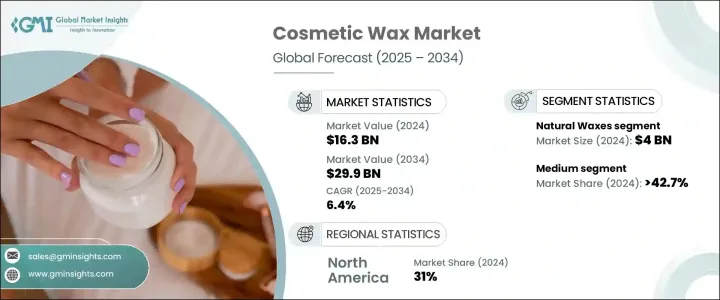
|
시장보고서
상품코드
1708165
화장품 왁스 시장 기회, 성장 촉진요인, 산업 동향 분석, 예측(2025-2034년)Cosmetic Wax Market Opportunity, Growth Drivers, Industry Trend Analysis, and Forecast 2025 - 2034 |
||||||
세계 화장품 왁스 시장은 2024년 163억 달러 규모로 2025년부터 2034년까지 연평균 6.4%의 성장률을 보일 것으로 예상됩니다. 이러한 성장의 배경에는 화장품 및 퍼스널케어 제품에 사용되는 성분에 대한 소비자의 인식이 높아지면서 천연, 유기농, 지속가능한 미용 제품에 대한 소비자의 선호도가 높아진 것이 주요 요인으로 작용하고 있습니다. 클린 뷰티 운동이 전 세계적으로 빠르게 확산되고 있는 가운데, 카르나우바, 칸델릴라, 밀랍과 같은 화장품 왁스는 친환경 제품 배합에 필수적인 역할을 하기 때문에 그 수요가 증가하고 있습니다. 이러한 왁스는 화장품의 질감, 보습 및 안정성을 향상시키는 데 필수적이며, 특히 립케어, 스킨케어, 헤어케어 등 다양한 뷰티 솔루션에 필수적인 성분으로 자리 잡고 있습니다.

업계를 선도하는 기업들은 그린 뷰티 트렌드로 변화하는 소비자의 우선순위에 맞춰 혁신적이고 고성능의 화장품 왁스 개발에 주력하고 있으며, 이는 시장 성장을 더욱 촉진하고 있습니다. 더 많은 브랜드가 투명성과 지속가능성을 추구함에 따라, 기능성과 환경적 매력을 모두 갖춘 고품질 화장품 왁스의 필요성이 그 어느 때보다 중요해지고 있습니다. 또한, 신흥국에서 고급 화장품 브랜드와 자연주의 화장품 브랜드가 확산됨에 따라 전 세계 화장품 왁스에 대한 수요는 더욱 증가할 것으로 보입니다. 소비자들은 성능에 타협하지 않으면서도 자연적인 혜택을 제공하는 제품에 매력을 느끼고 있으며, 화장품 왁스 시장은 이러한 역동적인 수요에 부응하기 위해 계속 진화하고 있습니다.
| 시장 범위 | |
|---|---|
| 시작 연도 | 2024년 |
| 예측 연도 | 2025-2034년 |
| 시작 금액 | 163억 달러 |
| 예상 금액 | 299억 달러 |
| CAGR | 6.4% |
시장은 천연 왁스, 합성 왁스, 미네랄 왁스, 파라핀 왁스, 몬탄 왁스 등 왁스 종류에 따라 분류됩니다. 천연 왁스 분야만 2024년 40억 달러를 창출하고 예측 기간 동안 CAGR 6.8%로 성장할 것으로 예상됩니다. 식물, 동물, 광물에서 추출되는 천연 왁스는 환경 친화적이고 지속가능하며 피부에 안전한 특성을 가지고 있습니다. 화장품 배합에 널리 사용되는 이 왁스는 제품에 부드러움, 보습, 안정성을 부여하는 데 크게 기여합니다. 클린 라벨과 친환경 화장품에 대한 소비자의 요구가 높아짐에 따라 천연 왁스는 지속가능성을 중시하는 브랜드에게 선호되는 선택이 되고 있습니다. 왁스의 구조적 무결성을 제공하고 감각적 매력을 향상시키는 왁스의 다재다능함은 뷰티 포뮬러의 필수 요소로 자리 잡으며 이 분야의 견고한 성장을 견인하고 있습니다.
시장은 저가, 중저가, 고가 왁스 등 가격대별로 세분화되어 있습니다. 중간 가격대는 2024년 42.7%의 점유율을 차지하며 2034년까지 CAGR 6.5%로 확대될 것으로 예상됩니다. 중저가 화장품 왁스는 합리적인 가격과 고급 품질의 균형을 이루기 때문에 대량 생산업체와 고급 제품 제조업체 모두에게 인기가 있습니다. 소비자들은 성능이나 고급 성분의 품질에 타협하지 않으면서도 비용 효율적인 중저가 화장품을 점점 더 선호하고 있으며, 이는 이 부문의 수요를 증가시키고 있습니다.
북미는 세계 시장 점유율의 31%를 차지하며 2024년 50억 6,000만 달러의 매출을 기록했으며, 미국이 이 지역을 주도하고 있습니다. 미국은 탄탄한 뷰티 산업과 고급, 천연, 유기농 퍼스널케어 제품에 대한 강한 의지로 인해 여전히 선두를 달리고 있습니다. 뷰티 혁신의 중심지로 인정받고 있는 미국은 지속가능하고 진보적인 화장품 배합에 대한 노력을 통해 전 세계 화장품 왁스 트렌드 형성에 매우 중요한 역할을 하고 있습니다.
목차
제1장 조사 방법과 조사 범위
제2장 주요 요약
제3장 업계 인사이트
- 산업 생태계 분석
- 공급업체 상황
- 가격 분석
- 테크놀러지와 혁신 전망
- 주요 뉴스와 이니셔티브
- 규제 상황
- 제조업체
- 판매업체
- 소매업체
- 영향요인
- 성장 촉진요인
- 내추럴·유기농 미용 제품에 대한 수요 증가
- 고급 퍼스널케어 제품의 인기 상승
- 화장품 처방의 기술 진보
- E-Commerce 미용 분야 성장
- 업계의 잠재적 리스크·과제
- 불안정한 원료 가격
- 합성 왁스에 대한 규제 제한
- 성장 촉진요인
- 소비자 구매 행동 분석
- 인구통계 동향
- 구매 결정에 영향을 미치는 요인
- 소비자의 제품 채용
- 선호 유통 채널
- 희망 가격대
- 성장 가능성 분석
- Porters 분석
- PESTEL 분석
제4장 경쟁 구도
- 소개
- 기업 시장 점유율 분석
- 경쟁 포지셔닝 매트릭스
- 전략 전망 매트릭스
제5장 시장 추정과 예측 : 유형별, 2021-2034년
- 주요 동향
- 천연 왁스
- 밀랍
- 카르나우바 왁스
- 칸데릴라 왁스
- 대두 왁스
- 기타(호호바 왁스, 팜 왁스 등)
- 합성 왁스
- 폴리에틸렌 왁스
- 피셔-트롭쉬 왁스
- 마이크로크리스탈린 왁스
- 기타(실리콘계 왁스, 아미드계 왁스 등)
- 광물성 왁스
- 파라핀 왁스
- 몬탄 왁스
- 기타(세레신 왁스, 오조케라이트 왁스 등)
제6장 시장 추정과 예측 : 가격별, 2021-2034년
- 주요 동향
- 저
- 중
- 고
제7장 시장 추정과 예측 : 형태별, 2021-2034년
- 주요 동향
- 고체
- 액체
- 플레이크
제8장 시장 추정과 예측 : 지역별, 2021-2034년
- 주요 동향
- 북미
- 미국
- 캐나다
- 유럽
- 영국
- 독일
- 프랑스
- 이탈리아
- 스페인
- 아시아태평양
- 중국
- 일본
- 인도
- 호주
- 라틴아메리카
- 브라질
- 멕시코
- 중동 및 아프리카
- 남아프리카공화국
- 사우디아라비아
- 아랍에미리트
제9장 기업 개요
- Body Wax Brazil
- CALWAX
- Cirepil
- Depileve
- Dow
- FILO BIANCO S.r.l.
- GiGi
- Italwax
- Koster Keunen
- LCM company
- Perron Rigot
- Rica Group
- Starpil Wax
- Tuel
- Xanitalia
The Global Cosmetic Wax Market was valued at USD 16.3 billion in 2024 and is projected to grow at a CAGR of 6.4% between 2025 and 2034. This significant growth is fueled by the rising consumer preference for natural, organic, and sustainable beauty products, as people are becoming increasingly aware of the ingredients used in cosmetics and personal care items. With the clean beauty movement rapidly gaining momentum worldwide, cosmetic waxes such as carnauba, candelilla, and beeswax are seeing higher demand for their essential role in formulating eco-friendly products. These waxes are indispensable for enhancing the texture, moisture retention, and stability of cosmetic products, making them vital ingredients in a wide array of beauty solutions, especially in lip care, skincare, and hair care formulations.

Industry leaders are focusing on developing innovative and high-performance cosmetic waxes that align with shifting consumer priorities toward green beauty trends, further supporting market growth. As more brands embrace transparency and sustainability, the need for high-quality cosmetic waxes that deliver both functionality and eco-appeal is becoming more critical than ever. Additionally, the growing penetration of premium and natural cosmetic brands in emerging economies is set to further elevate the demand for cosmetic waxes globally. With consumers gravitating towards products that offer natural benefits without compromising on performance, the cosmetic wax market continues to evolve to meet these dynamic demands.
| Market Scope | |
|---|---|
| Start Year | 2024 |
| Forecast Year | 2025-2034 |
| Start Value | $16.3 Billion |
| Forecast Value | $29.9 Billion |
| CAGR | 6.4% |
The market is segmented based on wax type, including natural, synthetic, mineral, paraffin, and montan waxes, among others. The natural wax segment alone generated USD 4 billion in 2024 and is anticipated to grow at a CAGR of 6.8% throughout the forecast period. Sourced from plants, animals, and minerals, natural waxes are celebrated for their eco-friendly, sustainable, and skin-safe properties. Widely used across cosmetic formulations, these waxes contribute significantly to adding smoothness, moisture, and stability in products. As consumer demand for clean-label and green cosmetics grows, natural waxes are becoming a preferred choice for brands committed to sustainability. Their versatility in offering structural integrity and enhancing sensory appeal makes them a staple in beauty formulations, helping drive robust growth in this segment.
The market is further classified based on price range, encompassing low, medium, and high-priced waxes. The medium price segment held a 42.7% share in 2024 and is projected to expand at a CAGR of 6.5% through 2034. Medium-priced cosmetic waxes strike a balance between affordability and premium quality, making them popular among mass-market and premium product manufacturers alike. Consumers increasingly prefer mid-range cosmetic products that provide cost-effectiveness without compromising performance or quality ingredients, which is pushing demand within this segment.
North America accounted for 31% of the global market share, generating USD 5.06 billion in 2024, with the United States leading the region. The U.S. remains at the forefront due to its established beauty industry and a strong appetite for high-end, natural, and organic personal care products. Recognized as a hub for beauty innovation, the country plays a pivotal role in shaping global cosmetic wax trends through its commitment to sustainable and advanced cosmetic formulations.
Table of Contents
Chapter 1 Methodology & Scope
- 1.1 Research design
- 1.1.1 Research approach
- 1.1.2 Data collection methods
- 1.2 Base estimates and calculations
- 1.2.1 Base year calculation
- 1.2.2 Key trends for market estimates
- 1.3 Forecast model
- 1.4 Primary research & validation
- 1.4.1 Primary sources
- 1.4.2 Data mining sources
Chapter 2 Executive Summary
- 2.1 Industry synopsis, 2021 - 2034
Chapter 3 Industry Insights
- 3.1 Industry ecosystem analysis
- 3.2 Supplier landscape
- 3.3 Pricing analysis
- 3.4 Technology & innovation landscape
- 3.5 Key news & initiatives
- 3.6 Regulatory landscape
- 3.7 Manufacturers
- 3.8 Distributors
- 3.9 Retailers
- 3.10 Impact forces
- 3.10.1 Growth drivers
- 3.10.1.1 Rising demand for natural and organic beauty products.
- 3.10.1.2 Increasing popularity of luxury personal care products.
- 3.10.1.3 Technological advancements in cosmetic formulations.
- 3.10.1.4 Growth of the e-commerce beauty sector.
- 3.10.2 Industry pitfalls & challenges
- 3.10.2.1 Volatile raw material prices.
- 3.10.2.2 Regulatory restrictions on synthetic waxes
- 3.10.1 Growth drivers
- 3.11 Consumer buying behavior analysis
- 3.11.1 Demographic trends
- 3.11.2 Factors affecting buying decision
- 3.11.3 Consumer product adoption
- 3.11.4 Preferred distribution channel
- 3.11.5 Preferred price range
- 3.12 Growth potential analysis
- 3.13 Porter's analysis
- 3.14 PESTEL analysis
Chapter 4 Competitive Landscape, 2024
- 4.1 Introduction
- 4.2 Company market share analysis
- 4.3 Competitive positioning matrix
- 4.4 Strategic outlook matrix
Chapter 5 Market Estimates and Forecast, By Type, 2021 – 2034 (USD Billion) (Million Units)
- 5.1 Key trends
- 5.2 Natural waxes
- 5.2.1 Beeswax
- 5.2.2 Carnauba wax
- 5.2.3 Candelilla wax
- 5.2.4 Soy wax
- 5.2.5 Others (jojoba wax, palm wax, etc.)
- 5.3 Synthetic waxes
- 5.3.1 Polyethylene wax
- 5.3.2 Fischer-tropsch wax
- 5.3.3 Microcrystalline wax
- 5.3.4 Others (silicone-based waxes, amide wax, etc.)
- 5.4 Mineral waxes
- 5.5 Paraffin wax
- 5.6 Montan wax
- 5.7 Others (ceresin wax, ozokerite wax, etc.)
Chapter 6 Market Estimates and Forecast, By Price, 2021 – 2034 (USD Billion) (Million Units)
- 6.1 Key trends
- 6.2 Low
- 6.3 Medium
- 6.4 High
Chapter 7 Market Estimates and Forecast, By Form, 2021 – 2034 (USD Billion) (Million Units)
- 7.1 Key trends
- 7.2 Solid
- 7.3 Liquid
- 7.4 Flake
Chapter 8 Market Estimates & Forecast, By Region, 2021 – 2034, (USD Billion) (Million Units)
- 8.1 Key trends
- 8.2 North America
- 8.2.1 U.S.
- 8.2.2 Canada
- 8.3 Europe
- 8.3.1 UK
- 8.3.2 Germany
- 8.3.3 France
- 8.3.4 Italy
- 8.3.5 Spain
- 8.4 Asia Pacific
- 8.4.1 China
- 8.4.2 Japan
- 8.4.3 India
- 8.4.4 Australia
- 8.5 Latin America
- 8.5.1 Brazil
- 8.5.2 Mexico
- 8.6 MEA
- 8.6.1 South Africa
- 8.6.2 Saudi Arabia
- 8.6.3 UAE
Chapter 9 Company Profiles
- 9.1 Body Wax Brazil
- 9.2 CALWAX
- 9.3 Cirepil
- 9.4 Depileve
- 9.5 Dow
- 9.6 FILO BIANCO S.r.l.
- 9.7 GiGi
- 9.8 Italwax
- 9.9 Koster Keunen
- 9.10 LCM company
- 9.11 Perron Rigot
- 9.12 Rica Group
- 9.13 Starpil Wax
- 9.14 Tuel
- 9.15 Xanitalia



















